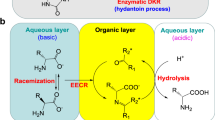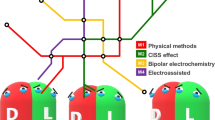Abstract
Kinetic resolutions play important roles in industrial biotransformations for production of optical pure compounds from racemic substrates. A simple method, based on enantiomeric excess of both substrate (ee S) and the corresponding product (ee P), was developed for determination of concentration of enantiomers in kinetic resolution. Since only relative quantity (ee) was required in the proposed method, calibration and cumbersome quantitative sample handling can be avoided and analytical accuracy can be greatly improved.
Similar content being viewed by others
Explore related subjects
Discover the latest articles, news and stories from top researchers in related subjects.Avoid common mistakes on your manuscript.
Introduction
With the steady growth of the importance of enantiomerically pure or enriched compounds in pharmaceuticals, agrochemicals and food additives, the so-called “chiral market” has become an expanding area of the fine chemicals industry (Reetz 2001). Kinetic resolution plays key roles in industrial biotransformations for production of enantiomerically pure compounds from racemic precursors (Straathof et al. 2002). In order to characterize enantioselectivity of enzymes and monitor the kinetic resolution progress, definitions, determination methods and relationships between vital parameters such as enantiomeric ratio (E), enantiomeric excess (ee) and the extent of conversion (c) have been established (Chen et al. 1982; Rakels et al. 1993; Straathof 1997). Besides these parameters, the concentration of enantiomers of both substrate and product is also of great importance to evaluate the kinetic resolution efficiency. However, direct determination of enantiomers usually requires quantitative treatment of samples such as solvent extraction, evaporation and derivatization steps, which might decrease the analytical precision.
With the development of chiral analysis technology (Ward 2002), enantioselective separations can be achieved for a wider variety of chiral compounds. Both enantiomeric excess of substrate (ee S) and the corresponding product (ee P) can be accurately measured in enzyme-catalyzed kinetic resolutions (Xu et al. 2004; Wielechowska and Plenkiewicz 2005; Zimmermann et al. 2006; Kotik et al. 2005; Romano et al. 2006; Berti et al. 2006), which make the determination of the concentration of enantiomers much simpler.
In this paper, we propose a simple method to determine concentration of enantiomers in kinetic resolution progress based on ee S, ee P and chiral balance (Straathof et al. 1995), which might be a useful alternative to the traditional method.
Theory
Suppose that enzyme involved in kinetic resolution is S-stereospecific, ee S and ee P can be expressed as Eqs. 1 and 2.
Where S R , S S , P R and P S are molar concentrations of enantiomers of both substrate and product.
For clarity, it is assumed that (R)/(S) configuration does not change during the reaction, which means that (R)-substrate is transformed into (R)-product and (S)-substrate into (S)-product. Using chiral balance, Eqs. 3 and 4 are afforded as follows:
Here, S S0 and S R0 are the initial concentrations of the two enantiomers of substrate. If the substrate is racemic, S S0 = S R0.
Using this set of 4 equations, 4 variables, S R , S S , P R and P S , can be calculated. For example, P R is calculated by substitution of the other three variables.
Materials and methods
Materials
Racemic 2,2-dimethylcyclopropanecarboxamide and racemic 2,2-dimethylcyclopropanecarboxylic acid were from Huakang Chemicals Ltd. (Zhejiang, China). All the other chemicals were obtained from commercial sources and were of analytical reagent grade purity.
Microorganisms and cultivation conditions
Two strains capable of producing enantioselective amidase, Delftia tsuruhatensis CCTCC M 205114 and Rhodococcus sp. N595, were isolated through a colorimetric high-throughput screening system (Zheng et al. 2007) in our laboratory. D. tsuruhatensis was grown at 30°C for 24 h (150 rpm) in a medium of the following composition: 10 g glucose l−1, 3.56 g acetamide l−1, 7.0 g yeast extraction l−1, 0.7 g peptone l−1, 1 g NaCl l−1, 1 g KH2PO4 l−1, 1 g K2HPO4 l−1 (pH 7.5). Rhodococcus sp. was grown at 30°C for 72 h (150 rpm) in a medium consisted of 10 g glucose l−1, 5 g yeast extract l−1, 2 g peptone l−1, 1 g KH2PO4 l−1, 1 g K2HPO4 l−1, 1 g NaCl l−1, 0.2 g MgSO4·7H2O l−1, 0.03 g FeSO4·7H2O l−1, and 1 g ε-caprolactam l−1 (pH 7.0).
Cells were harvested by centrifugation and the cell pellets were then suspended in 50 mM Tris–HCl buffer (pH 8.0) to give a resting cell concentration of 11.5 g l−1 (cell dry).
Biotransformations
Racemic amide, 0.3 mmol dissolved in 1 ml methanol and added to 9 ml of the above mentioned cell suspensions. The reaction mixtures were incubated at 35°C with stirring (120 rpm). Samples (500 μl each) were withdrawn at intervals and the reaction was quenched by addition of 30 μl HCl (5 M). After centrifugation, 200 μl supernatant was extracted with 800 μl ethyl acetate and vigorously mixed. The ethyl acetate layer was collected and dried over anhydrous Na2SO4.
Analytical methods
Enantiomeric compositions of residual substrate and the corresponding product were determined by GC on an enantioselective capillary column BGB-175. GC analysis was performed under the following conditions: carrier gas, helium; flow rate, 1.6 ml min−1; inlet temperature, 220°C; detector temperature, 220°C. For enantioselective separation of the acid, the initial column temperature was 90°C, with a 5°C min−1 gradient to 170°C, final 6 min at 170°C. For the amide, the column temperature was isothermal at 170°C.
Enantiomeric excess (ee) was defined as (A 1 − A 2)/(A 1 + A 2) × 100, where A 1 and A 2 were peak areas of the enantiomers, and A 1 was the larger peak area.
Results
The theory outlined above was used experimentally to determine the enantiomers of both substrate and product during the reaction progress. The kinetic resolution involved was amidase-catalyzed enantioselective hydrolysis of racemic 2,2-dimethylcyclopropanecarboxamide, which have been developed into industrial operation (Shaw et al. 2003) for the production of S-(+)-2,2-dimethylcyclopropanecarboxamide, a key chiral intermediate of Cilastatin (Birnbaum et al. 1985). Delftia tsuruhatensis produces an R-stereospecific amidase while Rhodococcus sp. contained nitrile hydratase associated.
S-stereospecific amidase
Changes of both ee S and ee P of the two reactions are listed in Table 1. The ee P of the reaction catalyzed by D. tsuruhatensis was higher than that catalyzed by Rhodococcus sp., which indicated that the amidase from D. tsuruhatensis had greater stereospecificity. Concentrations of the four enantiomers of substrates and products were sequentially calculated according to the equations. Fig. 1 shows changes in concentration of the four enantiomers during the reaction progress. As depicted in Fig.1B, R-amide was rapidly converted to R-acid while only 5.9% of S-amide was degraded when ee S reached 100%. In the Rhodococcus sp. catalyzed resolution, although the S-amide was degraded faster than the R-amide, the R-acid steadily accumulated. The residual concentration of the R-amide was 11.6 mm after 4 h when the ee S was only 92% (see Fig.1A).
Enantioselective amidase-catalyzed kinetic resolution of racemic-1 by (A) Rhodococcus sp. N595 and (B) Delftia tsuruhatensis CCTCC M 205114. Concentrations of enantiomers were calculated from corresponding ee S and ee P listed in Table 1: S-amide (○), R-amide (∇), S-acid (•), R-acid (▼)
Discussion
This method was successfully used to determine concentration of enantiomers in kinetic resolution. Enantiomeric excess, determined from the ratio of peak areas of (R) and (S)-enantiomers, is a relative quantity. When it is applied to determine concentration of enantiomers (absolute quantity), calibration and quantitative treatment of samples can be circumvented and analytical accuracy is ensured. For example, since chiral gas capillary columns coated with cyclodexin as chiral stationary phases are usually sensitive to water, solvent extraction should be performed prior to analysis. Quantitative extraction becomes a key step in the direct determination of enantiomers. With this method, extraction efficiency is no longer as important as it was because only the ratio of peak areas of the two enantiomers is required.
Determination of enantiomeric ratio (E) derived from enantiomeric excess of substrate and product has been reported (Rakels et al. 1993). Here we established a relationship between ee S, ee P and the concentration of enantiomers, allowing for the determination of absolute quantity from the relative quantity. As shown in Eq. 5, accumulation of errors and the sensitivity of the calculations for inaccuracies from the input data are not high. No model assumptions were involved in the establishment of the relationship and it was not necessary for the substrate to be racemic. The only limitation is that it is not valid when racemization occurs.
In summary, the method proposed here may be a useful alternative to determine concentration of enantiomers in kinetic resolution if ee S and ee P are available. Simple, rapid and accurate determination of enantiomers in reaction mixture will greatly facilitate investigations into enzyme-catalyzed kinetic resolutions.
Reference
Birnbaum J, Kahan FM, Kropp H, Macdonald JS (1985) Carbapenems, a new class of beta-lactam antibiotics: discovery and development of imipenem/cilastatin. Am J Med 78(Suppl. 6A):3–21
Berti F, Felluga F, Forzato C, Furlan G, Nitti P, Pitacco G, Valentin E (2006) Chemoenzymatic synthesis of diastereomeric ethyl γ-benzyl paraconates and determination of the absolute configurations of their acids. Tetrahedron: Asymmetry 17:2344–2353
Chen C-S, Fujimoto Y, Girdaukas G, Sih CJ (1982) Quantitative analyses of biochemical kinetic resolutions of enantiomers. J Am Chem Soc 104:7294–7299
Kotik M, Brichac J, Kyslík P (2005) Novel microbial epoxide hydrolases for biohydrolysis of glycidyl derivatives. J Biotechnol 120:364–375
Rakels JLL, Straathof AJJ, Heijnen JJ (1993) A simple method to determine the enantiomeric ratio in enantioselective biocatalysis. Enzyme Microb Technol 15:1051–1056
Reetz MT (2001) Combinatorial and evolution-based methods in the creation of enantioselective catalyst. Angew Chem Int Ed 40:284–310
Romano D, Ferrario V, Molinari F, Gardossi L, Montero JMS, Torre P, Converti A (2006) Kinetic resolution of (R, S)-1,2-O-isopropylideneglycerol by esterification with dry mycelia of moulds. J Mol Catal B: Enzymatic 41:71–74
Shaw NM, Robins KT, Kiener A (2003) Lonza: 20 years of biotransformations. Adv Synth Catal 345:425–435
Straathof AJJ, (1997) The enantiomeric ratio: origin, determination and prediction. Enzyme Microb Technol 21:559–571
Straathof AJJ, Panke S, Schmid A (2002) The production of fine chemicals by biotransformations. Curr Opin Biotechnol 13:548–556
Straathof AJJ, Rakels JLL, Heijnen JJ (1995) Mass balancing in kinetic resolution: calculating yield and enantiomeric excess using chiral balance. Biotechnol Bioeng 45:536–538
Ward TJ (2002) Chiral separations. Anal Chem 74:2863–2872
Wielechowska M, Plenkiewicz J (2005) Lipase-catalyzed separation of the enantiomers of 1-substituted-3-arylthio-2-propanols. Tetrahedron: Asymmetry 16:1199–1205
Xu Y, Xu JH, Pan J, Tang YF (2004) Biocatalytic resolution of glycidyl aryl ethers by Trichosporon loubierii: cell/substrate ratio influences the optical purity of (R)-epoxides. Biotechnol Lett 26:1217–1221
Zheng RC, Zheng YG, Shen YC (2007) A screening system for active and enantioselective amidase based on its acyl transfer activity. Appl Microbiol Biotechnol 74:256–262
Zimmermann V, Beller M, Kragl U (2006) Modelling the reaction course of a dynamic kinetic resolution of amino acid derivatives: identifying and overcoming bottlenecks. Org Process Res Dev 10:622–627
Acknowledgements
This work was supported by the Major Basic Research Development Program of China (No. 2003CB716005), Chinese national programs for high technology research and development (No. 2006AA02Z241) and Doctor Program of High Education of China (No.20051033701)
Author information
Authors and Affiliations
Corresponding author
Rights and permissions
About this article
Cite this article
Zheng, RC., Zheng, YG. & Shen, YC. A simple method to determine concentration of enantiomers in enzyme-catalyzed kinetic resolution. Biotechnol Lett 29, 1087–1091 (2007). https://doi.org/10.1007/s10529-007-9358-x
Received:
Revised:
Accepted:
Published:
Issue Date:
DOI: https://doi.org/10.1007/s10529-007-9358-x





